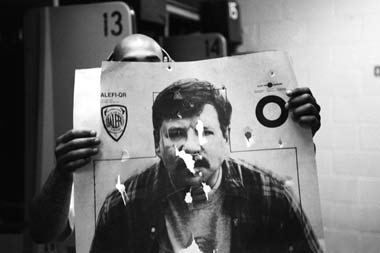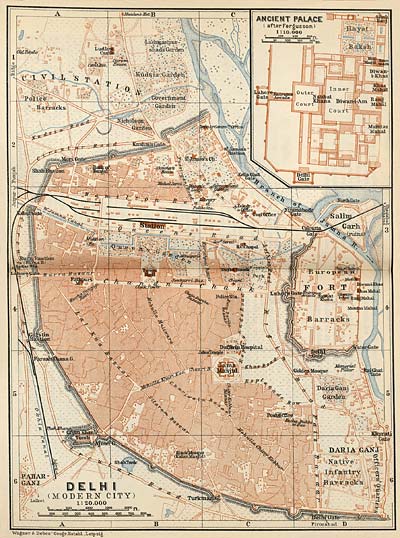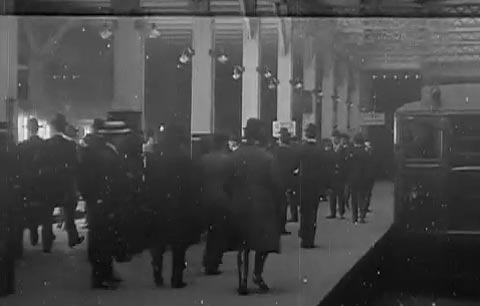within the world

Men and women have been pairing off since the dawn of humanity. For most of its history, marriage was an economic institution that created advantageous alliances between clans and was arranged, often, without much input from the bride or groom. But by the 19th century, many in the Western world had begun to marry for love, making the relationship infinitely more complicated and divorce a lot more common.
Romantic love assumed a position of high value but even higher vulnerability.
Still, until the second half of the 20th century, these ubiquitous couplings went largely unstudied. What happened behind closed doors generally remained private, unless one had a particularly nosy set of in-laws or a manner of fighting that necessitated police intervention.
Marriages, with the power to affect everything from personal income levels to mental and physical health, remained a hazy mystery. But with the advent of the affordable video camera in the late 1960s, psychologists began recording couples’ interactions. The scientists hooked up their subjects to monitors that detected changes in blood pressure or stress hormones, and then coded even their slightest movements — an eye roll or a knuckle crack. The couples were interviewed about their marital satisfaction and were, in some cases, tracked for years.
{ Washington Post | Continue reading }
Unhappy couples in New York have long gone to extremes to throw off the shackles of matrimony—in the worst cases, framing their spouses, producing graphic testimony about affairs, or even confessing to crimes they did not commit. All this will fade into the past if, as expected, Gov. David Paterson signs a bill making New York the last state in the country to adopt unilateral no-fault divorce.
Their counterparts in other states have had it much easier. California adopted the first no-fault divorce bill in 1970; by 1985, every other state in the nation—but one—had passed similar laws. In New York, the miserably married must still charge each other with cruel and inhuman treatment, adultery or abandonment—or wait one year after a mutually agreed legal separation—in order to divorce.
{ Wall Street Journal | Continue reading }
law, new york, relationships | December 2nd, 2010 2:16 pm

In 2005, the French city of Lyon introduced a shared bicycle system called Velo’v that has since inspired numerous other schemes around the world.
Velo’v differed from earlier schemes in its innovative technology, such as electronic locks, onboard computers and access via smart cards. The system now offers some 4000 bikes at almost 350 stations around the city. (…)
Since its introduction, the system has kept track of the start and finishing location plus travel time of every journey. Today, we get a detailed analysis of this data. (…)
Some of what they found is unsurprising. Over an average trip, cyclists travel 2.49 km in 14.7 minutes so their average speed is about 10 km/h. (…) During the rush hour, however, the average speed rises to almost 15 km/h, a speed which outstrips the average car speed. (…)
Curiously, the Wednesday morning speeds are systematically higher than on other days, even though there is no change in other factors such as the number of cars. This, say Jensen and co, is probably because women tend to stay at home and look after their children on a Wednesday in France. So the higher proportion of men pushes up the average speed.
{ The Physics arXiv Blog | Continue reading }
leisure, science, transportation, within the world | December 2nd, 2010 2:00 pm

America remains the world’s richest large country. It’s generally estimated to have a per capita GDP level around $45,000, while the richest European nations manage only a $40,000 or so per capita GDP (setting aside low population, oil-rich states like Norway). Wealth underlies America’s sense of itself as a special country, and it’s also cited as evidence that America is better than other economies on a range of variables, from economic freedom to optimism to business savvy to work ethic.
But why exactly is America so rich? Karl Smith ventures an explanation:
I am going to go pretty conventional on this one and say a combination of three big factors
1. The Common Law
2. Massive Immigration
3. The Great Scientific Exodus during WWII
{ The Economist | Continue reading }
related { 5 Myths about the Fed }
photo { Young Kyu Yoo }
U.S., economics | November 30th, 2010 7:00 pm

The Ford Crown Victoria has long been the most widely used vehicle in New York City’s taxi fleet. But Ford is retiring the Crown Vic next year, and that means NYC needs to find a replacement.
Enter the Taxi of Tomorrow competition, a project created by city officials to find the next major taxi model.
So far, the city has narrowed the competition down to three finalists. The winner, which will be picked next year, will have an exclusive contract to provide the city with taxi cabs.
{ Fast Company | Continue reading }
In 2007, TLC’s Board of Commissioners approved a new package of taxi stickers. Smart Design, a design firm, produced and donated the new logo designs to TLC.
Taxi drivers and owners purchased the stickers from authorized printers.
The 4 stickers (per vehicle side) in the logo package were: a fare panel, the NYCTAXI sticker, the medallion number and a checker stripe decal.
{ NYC.gov | Continue reading }
new york, transportation, visual design, zzzzzzzzz | November 30th, 2010 8:50 am

In 1978, the divorce rate was much higher than it is today. (…)
Americans still venerate marriage enough to want to try it. About 70% of us have been married at least once, according to the 2010 Census. (…)
41% of babies were born to unmarried moms in 2008, an eightfold increase from 50 years ago, and 25% of kids lived in a single-parent home, almost triple the number from 1960. Contrary to the stereotype, it turns out that most of the infants born to unmarried mothers are not the product of casual sexual encounters. (…)
Most of those unwed mothers said their chances of marrying the baby’s father were 50% or greater, but after five years, only 16% of them had done so and only about 20% of the couples were still cohabiting. This didn’t mean that the children didn’t live with a man, however, since about a quarter of their moms were now living with or married to a new partner.
{ Time | Continue reading }
screenshot { Michelangelo Antonioni, The Eclipse, 1962 }
U.S., kids, relationships | November 29th, 2010 6:56 pm

In an interesting display of Greco-Turkish friendship, visitors from the Greek mainland joined with locals in the coastal Aegean village of Yagcilar as they gathered to watch bulldozers and men with shovels move in on the former home of a Greek Orthodox priest.
Under normal circumstances the demolition of a holy man’s home and the excavation of his garden would have prompted political commentary, but in this case the events had been arranged collaboratively by the current Turkish landowners, the great grandchildren of the exiled priest, the Ministry for Culture and Antiquities, and the governor of the district of Urla.
The aim of the excavators was to uncover 400 kilograms of gold and money buried in the garden in the mid-1920s for safekeeping. It had been entrusted to the priest by his religious community as they found themselves forced to evacuate Greece in the exchange of population that took place at the time.
The tip on the whereabouts of the treasure came from a diary entry found by the priest’s descendents, in which he indicates that he hid the money on the grounds of his house. After three days of searching, nothing but dirt was unearthed, leaving the treasure hunters with suspicions that the priest may have protected the treasure with a special spell.
In desperation, Turks called in a well known local hoca, a local religious leader, to pray at the site. Eyyup Hoca directed the operation to new areas to in which to dig and, with the second excavation attempt coming out empty-handed, he announced that jinn (fairies or imps) had changed the hiding place of the money every 41 years since the date of its burial. This was accepted as a reasonable explanation, and the quest continues.
The concept and existence of jinn is widely accepted in Islam. God is said to have created the jinn before humans from “hot wind” and “smokeless fire”, and some jinn are Muslim. Like humans they were invested with intellect, discrimination, freedom and the power to choose between right and wrong. They live all over earth on a separate plane of existence from man and cannot easily be seen, though they are often thought to take the shape of snakes and black dogs.
It is believed that some areas are particularly attractive to jinn - deserts, ruins and places of impurities such as dunghills, bathrooms and graveyards - but jinn can quite easily live alongside humans in their homes.
{ Asia Times | Continue reading }
asia, mystery and paranormal, weirdos | November 24th, 2010 5:15 pm

New York City in the 1920s and ’30s was a hotbed of criminal activity. Prohibition laws banning the production, sale and distribution of alcohol had been introduced, but instead of reducing crime, they had the opposite effect. Gangsters organized themselves and seized control of the alcohol distribution racket, smuggling first cheap rum from the Caribbean, then French champagne and English gin, into the country. Speakeasies sprang up in every neighbourhood, and numbered more than 100,000 by 1925. When prohibition was abolished in 1933, the gangsters took to other activities, such as drug distribution, and crime rates continued to increase.
At the forefront of the city’s efforts to keep crime under control was a man named Carleton Simon. Simon trained as a psychiatrist, but his reach extended far beyond the therapist’s couch. He became a ‘drug czar’ six decades before the term was first used, spearheading New York’s war against drug sellers and addicts. He was a socialite and a celebrity, who made a minor contribution to early forensic science by devising new methods to identify criminals. He also tried to apply his knowledge to gain insights into the workings of the criminal brain, becoming, effectively, the first neurocriminologist.
Simon was born in New York City on February 28th, 1871, and studied in Vienna and Paris, graduating with an M.D. in 1890. Afterwards, he conducted sleep research. (…) Eventually, Simon became interested in criminology and psychopathology, and by the turn of the century had abandoned his psychiatric research to focus on these disciplines. (…)
Towards the end of the 1930s crime was estimated to cost the U.S. approximately $15 billion annually. Knowledge of brain function and dysfunction was very rudimentary by today’s standards, and criminals and psychopaths were often lobotomized or subjected to electroconvulsive therapy in order to keep them under control. Another treatment available was insulin shock therapy, which had been introduced by Manfred Sakel in 1933, and involved giving patients large repeated doses of the hormone to induce coma. It was around this time that Simon proposed a new theory, which he believed would help science to understand and control the criminal mind.
The theory drew on the concept of cerebral dominance, which had emerged some 70 years earlier, largely from Paul Broca’s investigations of stroke patients. (…) According to Simon’s theory, criminality occurs as a result of a shift in cerebral dominance, whereby the normally submissive right hemisphere gains mastery of the brain, leading to irrational behaviour.
{ Neurophilosophy | Continue reading }
photo { Alessandro Zuek Simonetti }
flashback, neurosciences, new york, science | November 24th, 2010 4:10 pm

Taliban Leader in Peace Talks Was an Impostor
For months, the secret talks unfolding between Taliban and Afghan leaders to end the war appeared to be showing promise, if only because of the appearance of a certain insurgent leader at one end of the table: Mullah Akhtar Muhammad Mansour, one of the most senior commanders in the Taliban movement.
But now, it turns out, Mr. Mansour was apparently not Mr. Mansour at all. In an episode that could have been lifted from a spy novel, United States and Afghan officials now say the Afghan man was an impostor, and high-level discussions conducted with the assistance of NATO appear to have achieved little.
“It’s not him,” said a Western diplomat in Kabul intimately involved in the discussions. “And we gave him a lot of money.”
{ NY Times | Continue reading }
photo { Jacques-André Boiffard, 1930 }
U.S., asia, haha, scams and heists | November 23rd, 2010 2:24 pm
art, new york | November 18th, 2010 9:17 am

A long-time Hollywood publicist was fatally shot inside her Mercedes-Benz, which then crashed into a light pole in Beverly Hills. Ronni Chasen, 64, was shot five times in the chest around 12:30 a.m. near Whittier Drive and Sunset Boulevard, according to Beverly Hills police.
Officers responding to the scene found Chasen’s black, late-model E-350 sedan crashed into a light pole on Whittier just south of Sunset. Chasen was taken to Cedars-Sinal Medical Center, where she was pronounced dead, according to the coroner’s office.
Police said they had no information about a suspect or motive for the shooting.
Chasen, the former senior vice president of worldwide publicity at MGM, was a well-known figure in Hollywood film and publicity circles. (…)
Chasen’s death was the third homicide this year in Beverly Hills.
{ Fox | Continue reading }
photo { On May 1, 1947, Evelyn McHale leapt to her death from the observation deck of the Empire State Building. Photographer Robert Wiles took a photo of McHale a few minutes after her death. }
guns, incidents, l.a. pros and cons | November 17th, 2010 6:28 pm

Does the Fed print money? If so, how?
It’s true that the Fed is not literally printing the $20 bills that end up in your wallet. As a commenter on your own blog has noted, that’s the job of the Bureau of Printing and Engraving. But money includes both currency in circulation and the reserves that commercial banks keep on deposit at the Fed. By that definition, the Fed is indeed printing it.
Here’s how QE works. The Fed buys a $100 bond from Bank of America. The bond gets added to the Fed’s assets. Bank of America has an account at the Fed. The Fed, with a keystroke, puts a $100 into B of A’s account. Where did the money come from? Thin air. Bank of America can visit its friendly neighborhood Fed branch and withdraw that $100 in the form of bills and coins. So for practical purposes the distinction between currency and reserves is meaningless; the monetary base includes both.
{ Greg Ip/Reuters | Continue reading }
photo { Steven Ahlgren }
U.S., economics | November 9th, 2010 11:33 pm

Why war? Darwinian explanations, such as the popular “demonic males” theory of Harvard anthropologist Richard Wrangham, are clearly insufficient. They can’t explain why war emerged relatively recently in human prehistory—less than 15,000 years ago, according to the archaeological record—or why since then it has erupted only in certain times and places.
Many scholars solve this problem by combining Darwin with gloomy old Thomas Malthus. “No matter where we happen to live on Earth, we eventually outstrip the environment,” the Harvard archaeologist Steven LeBlanc asserts. “This has always led to competition as a means of survival, and warfare has been the inevitable consequence of our ecological-demographic propensities.” Note the words “always” and “inevitable.”
LeBlanc is as wrong as Wrangham. Analyses of more than 300 societies in the Human Relations Area Files, an ethnographic database at Yale University, have turned up no clear-cut correlations between warfare and chronic resource scarcity. (…)
War is both underdetermined and overdetermined. That is, many conditions are sufficient for war to occur, but none are necessary. Some societies remain peaceful even when significant risk factors are present, such as high population density, resource scarcity, and economic and ethnic divisions between people. Conversely, other societies fight in the absence of these conditions. What theory can account for this complex pattern of social behavior?
The best answer I’ve found comes from Margaret Mead, who as I mentioned in a recent post is often disparaged by genophilic researchers such as Wrangham. Mead proposed her theory of war in her 1940 essay “Warfare Is Only an Invention—Not a Biological Necessity.” She dismissed the notion that war is the inevitable consequence of our “basic, competitive, aggressive, warring human nature.” This theory is contradicted, she noted, by the simple fact that not all societies wage war. War has never been observed among a Himalayan people called the Lepchas or among the Eskimos. In fact, neither of these groups, when questioned by early ethnographers, was even aware of the concept of war. (…)
Warfare is “an invention,” Mead concluded, like cooking, marriage, writing, burial of the dead or trial by jury. Once a society becomes exposed to the “idea” of war, it “will sometimes go to war” under certain circumstances.
{ Scientific American | Continue reading }
fights, ideas, science, theory, within the world | November 9th, 2010 6:26 pm

New Yorkers are accustomed to strong odors, but several years ago a new aroma began wafting through the city’s streets, a smell that was more unnerving than the usual offenders (trash, sweat, urine) precisely because it was so delightful: the sweet, unmistakable scent of maple syrup. It was a fickle miasma, though, draping itself over Morningside Heights one afternoon, disappearing for weeks, reemerging in Chelsea for a few passing hours before vanishing again. Fearing a chemical warfare attack, hundreds of New Yorkers reported the smell to authorities. (…) The city quickly determined that the odor was harmless, but the mystery of its origin persisted for four years.
During maple syrup events, as they came to be called, operators at the city’s popular NYC311 call center—set up to field complaints and provide information on school closings and the like—were instructed to reassure callers that they could go about their business as usual.
But then city officials had an idea. Those calls into the 311 line, they realized, weren’t simply queries from an edgy populace. They were clues.
On January 29, 2009, another maple syrup event commenced in northern Manhattan. The first reports triggered a new protocol that routed all complaints to the Office of Emergency Management and Department of Environmental Protection, which took precise location data from each syrup smeller. Within hours, inspectors were taking air quality samples in the affected regions. The reports were tagged by location and mapped against previous complaints. A working group gathered atmospheric data from past syrup events: temperature, humidity, wind direction, velocity.
Seen all together, the data formed a giant arrow aiming at a group of industrial plants in northeastern New Jersey. A quick bit of shoe-leather detective work led the authorities to a flavor compound manufacturer named Frutarom, which had been processing fenugreek seeds on January 29. Fenugreek is a versatile spice used in many cuisines around the world, but in American supermarkets, it’s most commonly found in the products on one shelf—the one where they sell cheap maple-syrup substitutes.
Fifteen months after the Maple Syrup Mystery was solved, mayor Michael Bloomberg paid a visit to the 311 call center. (…) Launched in March 2003, 311 now fields on average more than 50,000 calls a day, offering information about more than 3,600 topics: school closings, recycling rules, homeless shelters, park events, pothole repairs. The service has translators on call to handle some 180 different languages.
{ Wired | Continue reading }
photo { Mark Borthwick }
mystery and paranormal, new york, olfaction | November 9th, 2010 6:06 pm
flashback, new york, transportation | November 9th, 2010 5:00 pm
costumes, new york | November 7th, 2010 3:12 pm

China may not matter quite as much as you think
It is hard to exaggerate the Chinese economy’s far-reaching impact on the world, from small towns to big markets. It accounted for about 46% of global coal consumption in 2009, according to the World Coal Institute, an industry body, and consumes a similar share of the world’s zinc and aluminium. In 2009 it got through twice as much crude steel as the European Union, America and Japan combined. It bought more cars than America last year and this year looks set to buy more mobile phones than the rest of the world put together, according to China First Capital, an investment bank.
In China growth of 9.6% (recorded in the year to the third quarter) represents a slowdown. China will account for almost a fifth of world growth this year, according to the IMF; at purchasing-power parity, it will account for just over a quarter. (…)
Since the crisis, China has shown that its economy can grow even when America’s shrinks. It is not entirely dependent on the world’s biggest economy. But that does not mean it can substitute for it.
{ The Economist | Continue reading }
photo { Thomas Prior }
asia, economics | November 4th, 2010 2:35 pm
asia, gross, haha, video, weirdos | November 4th, 2010 2:22 pm

You write in Art is Work that the very famous “I ‘Heart’ New York” logo you designed was originally proposed as something else.
It was just a little typographical solution with two lozenges and a word in it, two ovals, and the word inside it; it was not in any way distinguished. But I always thought the whole thing was going to be a three-month campaign.
{ Interview with Milton Glaser | The Believer | Continue reading | Images: I Love NY and New York magazine logotypes designed by Milton Glaser | video: The “I Love New York” Ad Campaign Origin }
related { An Introduction to Graphic Design | Design Observers | full story }
new york, visual design | November 2nd, 2010 8:58 am

Something has been bothering me lately and it is our assumption that China is the world’s next superpower and that we’d darned well better get used to it. Hogwash. We’re into the Chinese decade, not the Chinese Century.
The century belongs to India. (…)
China has the population, the will, the educational system, the foreign currency reserves — everything to make it the next global superpower except two things: 1) an emerging middle class generation comparable to our Baby Boomers, and; 2) a functional diaspora (look it up, I’ll wait).
In contrast to China, India has only those two things: 1) a real Baby Boomer class, and; 2) a functional diaspora (did you look it up?). Nothing else about India works at all — nothing. India is corrupt and divided. While India has a commercial tradition it isn’t an especially functional one. Fractionalism and factionalism, whether economic, social, or religious, will keep India from ever truly pulling together. But that doesn’t matter because my two original points are enough.
{ Robert X. Cringely | Continue reading }
map { Delhi (Modern City), 1914 | enlarge | more }
asia, economics | November 1st, 2010 4:15 pm

I answered, “If you’re a terrorist, you’re going to hide your weapons in your anus or your vagina.”
“Yes, but starting tomorrow, we’re going to start searching your crotchal area–this is the word he used, ‘crotchal’–and you’re not going to like it.”
“What am I not going to like?” I asked.
“We have to search up your thighs and between your legs until we meet resistance,” he explained.
{ The Atlantic | Continue reading }
photo { Ralph Mecke }
U.S., airports and planes, law | October 31st, 2010 8:05 am























